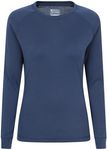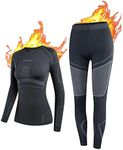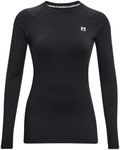Buying Guide for the Best Thermals For Women
When choosing thermals for women, it's important to consider the specific needs and activities you'll be engaging in. Thermals are designed to provide warmth and comfort in cold conditions, making them essential for outdoor activities, winter sports, or simply staying cozy indoors. The right pair of thermals can make a significant difference in your comfort level, so understanding the key specifications will help you make an informed decision.MaterialThe material of thermals is crucial because it determines the warmth, breathability, and comfort of the garment. Common materials include wool, synthetic fibers, and cotton. Wool, especially merino wool, is excellent for warmth and moisture-wicking, making it ideal for cold weather activities. Synthetic fibers like polyester are lightweight and quick-drying, suitable for active wear. Cotton is comfortable but not as effective in moisture management, so it's better for less intense activities. Consider your activity level and preference for warmth and breathability when choosing the material.
FitThe fit of thermals affects both comfort and performance. A snug fit is essential for thermals to effectively trap body heat and wick moisture away from the skin. However, it shouldn't be too tight as to restrict movement or cause discomfort. Thermals come in various fits, from form-fitting to more relaxed styles. If you're engaging in high-intensity activities, a tighter fit may be beneficial, whereas a looser fit might be more comfortable for casual wear. Consider your personal comfort and the type of activity you'll be doing when selecting the fit.
WeightThermal weight refers to the thickness and warmth of the garment. Lightweight thermals are suitable for mild conditions or as a base layer under other clothing. Midweight thermals offer more warmth and are versatile for various activities and temperatures. Heavyweight thermals provide maximum warmth and are ideal for extremely cold conditions or low-activity situations. Your choice should depend on the climate you'll be in and the level of activity you anticipate. For layering, lightweight or midweight options are often preferred.
Moisture-wickingMoisture-wicking is the ability of the fabric to draw sweat away from your skin and allow it to evaporate. This feature is important to keep you dry and comfortable, especially during physical activities. Fabrics like merino wool and certain synthetics excel in moisture-wicking. If you plan to use thermals for sports or outdoor activities, prioritize moisture-wicking properties to prevent discomfort from sweat accumulation. For less active use, this feature might be less critical but still beneficial for overall comfort.
Odor resistanceOdor resistance is a feature that helps keep thermals smelling fresh even after extended wear. This is particularly important for active individuals or those who plan to wear thermals for long periods without washing. Materials like merino wool naturally resist odors, while some synthetic fabrics are treated to enhance this property. If you're using thermals for sports or travel, odor resistance can be a valuable feature to look for. For casual use, it might be less of a priority but still a nice addition.

















